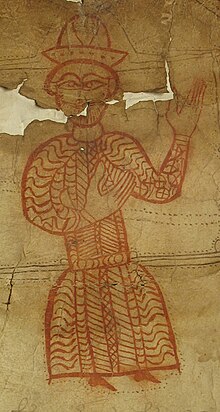George VII of Georgia
| George VII | |
|---|---|
 George VII from 1393-1400 royal charter | |
| King of Georgia | |
| Reign | 1393–1407 |
| Coronation | 1369 as co-king |
| Predecessor | Bagrat V |
| Successor | Constantine I |
| Born | 1360s |
| Died | 1407 |
| Burial | |
| Spouse | Nestan-Darejan |
| Dynasty | Bagrationi |
| Father | Bagrat V of Georgia |
| Mother | Helena Megale Komnene |
| Religion | Georgian Orthodox Church |
| Khelrtva |  |
George VII (Georgian: გიორგი VII, romanized: giorgi VII) (died 1405 or 1407) of the Bagrationi dynasty, was king (mepe) of the Kingdom of Georgia from 1393 until his death in 1407 (alternatively, from 1395 to 1405).[1]
Early life
[edit]George born in the 1360s, he was the eldest son of Bagrat V of Georgia and his first wife Helena Megale Komnene, who died of the Bubonic plague in 1366.[2] A year after her death, Bagrat married Anna of Trebizond, daughter of Alexios III of Trebizond.[3]
He became a co-king with his father in 1369,[4] the co-optation of George may have been called for by the birth of Anna's first son, Constantine, to ensure George's rights in the face of a half-brother by a far more illustrious mother.[5]
In 1386 Timur besieged Tbilisi, where the Georgian nobles abandoned Bagrat V and retreated to their castles. Tbilisi fell on November 22, 1386, its inhabitants were massacred, and Bagrat was captured. In Bagrat's absence, George was offered the crown, but he refused, fearing for his father's life in captivity. In order to regain his freedom, Bagrat pretended to convert to Islam, and Timur sent him back with a strong army of 12,000 men who were to enforce the conversion of Georgia to Islam. Bagrat secretly informed his sons Constantine and George, who gathered an army and ambushed Timur's troops in a gorge, freed their father and withdrew to Tbilisi.[6][7]
In 1392, George I of Imereti was killed during campaign against Vameq I Dadiani, allowing Prince George to unite with the great feudal lords of the West Georgia and invade the rebellious territories. The Kingdom of Western Georgia was annexed by Kingdom of Georgia, while the surviving members of the rebel family took refuge in the Caucasus Mountains.[8][9][10]
Reign
[edit]
In 1393, Bagrat died and George assumed full royal powers. He spent most of his reign fighting Timur who led seven more expeditions against the stubborn Georgian kingdom from 1387 to 1403, leaving the country in ruins.
In 1396, Constantine who has been exiled to the North Caucasus took advantage of the Timurid invasions of Georgia and the death of Vameq I Dadiani, he returned to Imereti and organized a new rebellion.[8] Without much resistance, the new rebel captured numerous fortresses and had himself crowned Constantine II of Imereti, but failed to unite with the region's great feudal lords. After demanding the vassalization of the dukes of Svaneti, Mingrelia and Guria, but he was killed in 1401. As Constantine was childless, the crown of the Kingdom of Western Georgia was to be passed on to his young and weak nephew, Demetrius, George VII who took advantage of a temporary ceasefire with Timur to invade western Georgia and once again put an end to the separatist kingdom.[11][12][13]
In 1399, George VII attacked the Timurid army besieging the castle of Alinja. The Georgian army cut it way through the besiegers temporarily freeing the Jalayirid Prince Tahir and some of those inside the castle, while the Timurid general Seif ad-Din fled.[14][15][4] While the Georgian army was withdrawing from the castle, an army sent by Miran Shah under the command of Abu Bakr arrived and a battle broke out. As the Timurid army advanced the Georgians attacked, resulting in a Georgian victory.[4][16]
This event prompted Timur to return in 1399. He captured Shaki and devastated the neighboring region of Hereti and Kakheti.[17] In the spring of 1400, Timur moved back to destroy the Georgian state once and for all. He demanded that George should hand over the Jalayirid Tahir but George refused with explanation that this would be against the Caucasian traditions and met Timur at the Sagim River in Kvemo Kartli, but suffered a defeat.[18] After the war, of those who survived the fighting and reprisals, many thousands died of hunger and disease, and 60,000 survivors were enslaved and carried away by Timur's troops.[19]
In late 1401, Timur invaded the Georgia once again.[20] George VII had to sue for peace, and sent his brother Constantine with the contributions. Timur made peace with George on condition that the King of Georgia supplied him troops during his campaign against Ottoman Empire and granted the Muslims special privileges.[21] Once the Ottomans were defeated at the Battle of Ankara, Timur, back to Erzurum in 1402, decided to punish George VII for not having come to present his congratulations on his victory. Historians reported that 700 towns were destroyed and their inhabitants massacred by Timurid forces.[22][23]
In the aftermath of Timur's death in February 1405 and the subsequent power struggles among his heirs, Timur's empire became fragmented as Miran Shah and his sons struggled over control of Persia. In the midst of this chaos, George, who had returned from Imereti, engaged in battles to regain lost territories. He managed to conquer Nakhchivan and Ganja while also causing destruction in places like Ani, Erzurum, and Tabriz. Despite commanding an army of merely 5,000 men, George succeeded in expanding Georgia's borders temporarily to their former extent.[24]
According to Vakhushti of Kartli, he was killed in battle against the Turkoman nomads, apparently of the Qara Qoyunlu clan. Today, some historians consider this information of Vakhushti doubtful and claim that George VII died of natural causes.[25]
George VII may have died childless, as his brother Constantine I became the next king.
See also
[edit]References
[edit]- ^ Kʻartʻuli diplomatiis istoriis narkvevebi (in Georgian). Tʻbilisis universitetis gamomcʻemloba. 1998. pp. 530–543. ISBN 978-5-511-00896-7.
- ^ Ivane Javakhishvili, The History of the Georgian Nation, vol. 3, Tbilisi, 1982, p.180
- ^ "Dictionary of Georgian National Biography: "Bagrat V"". Archived from the original on 2012-02-27. Retrieved 2010-05-06.
- ^ a b c Rayfield 2012, p. 149.
- ^ Toumanoff 1949–1951, p. 173.
- ^ Baumer 2023, pp. 74–75.
- ^ Rayfield 2012, p. 148.
- ^ a b Brosset 1856, p. 248.
- ^ Bagrationi, Vakhushti (1976). Nakashidze, N.T. (ed.). История Царства Грузинского [History of the Kingdom of Georgia] (PDF) (in Russian). Tbilisi: Metsniereba. pp. 129–130.
- ^ Toumanoff, Cyril (1949–51). "The Fifteenth-Century Bagratids and the Institution of Collegial Sovereignty in Georgia". Traditio. 7: 183.
- ^ Brosset 1856, p. 249.
- ^ Toumanoff, Cyril (1949–51). "The Fifteenth-Century Bagratids and the Institution of Collegial Sovereignty in Georgia". Traditio. 7: 183.
- ^ Bagrationi, Vakhushti (1976). Nakashidze, N.T. (ed.). История Царства Грузинского [History of the Kingdom of Georgia] (PDF) (in Russian). Tbilisi: Metsniereba. pp. 41–42.
- ^ Bedrosian 1997, p. 268.
- ^ Baumer 2023, p. 75.
- ^ Javakhishvili 1949, p. 193.
- ^ Hodong Kim, "The Early History of the Moghul Nomads: The Legacy of the Chaghatai Khanate." The Mongol Empire and Its Legacy. Ed. Reuven Amitai-Preiss i David Morgan. Leiden: Brill, 1998.
- ^ Mirza Muhammad Haidar. The Tarikh-i-Rashidi (A History of the Moghuls of Central Asia). Traduit per Edward Denison Ross, editat per N. Elias. Londres, 1895.
- ^ Minorsky, Vladimir, "Tiflis", in: M. Th. Houtsma, E. van Donzel (1993), E. J. Brill's First Encyclopaedia of Islam, 1913–1936, p. 757. Brill, ISBN 90-04-08265-4.
- ^ Beatrice Forbes Manz, The Rise and Rule of Tamerlane. Cambridge University Press: Cambridge, 1989. ISBN 0-521-63384-2
- ^ Sicker, Martin (2000), The Islamic World in Ascendancy: From the Arab Conquests to Siege of Vienna, p. 155. Praeger, ISBN 0-275-96892-8.
- ^ The Empire of the Steppes: A History of Central Asi
- ^ Minorsky, Vladimir, "Tiflis", in: M. Th. Houtsma, E. van Donzel (1993), E. J. Brill's First Encyclopaedia of Islam, 1913–1936, p. 757. Brill, ISBN 90-04-08265-4.
- ^ Rayfield 2012, p. 152.
- ^ Tavadze, L. (2008) About the reasons of Georgian King George VII death, Studies in the Middle Ages History of Georgia, Vol. IX. p. 41–45 ISBN 978-9941-12-174-6
Sources
[edit]- Baumer, Christoph (2023). History of the Caucasus. Bloomsbury Publishing. ISBN 9780755636303.
- Brosset, Marie-Félicité (1856). Histoire de la Géorgie depuis l'Antiquité jusqu'au XIXe siècle - IIe partie: Histoire moderne. Saint Petersburg Academy of Sciences.
- Javakhishvili, Ivane (1949). Histoire de la Géorgie. XIe – XVe siècles (in Georgian). Tbilisi: Publication d'État de la RSS de Géorgie..
- Minorsky, Vladimir (1930). Transcaucasica (in French). Librairie orientaliste Paul Geuthner.
- Rayfield, Donald (2012). Edge of Empires : A History of Georgia. Reaktion Books.
- Bedrosian, Robert (1997). "Armenian during the Seljuk and Mongol Periods". In Hovannisian, Richard G. (ed.). The Armenian People From Ancient to Modern Times. Vol. I: The Dynastic Periods: From Antiquity to the Fourteenth Century. St. Martin's Press.
- Toumanoff, Cyril (1949–1951). The Fifteenth-Century Bagratids and the Institution of Collegial Sovereignty in Georgia.
Further reading
[edit]- ჯავახიშვილი ივ., ქართველი ერის ისტორია, წგ. 3, თბ., 1982 (თხზ. თორმეტ ტომად, ტ. 3).
- კაციტაძე დ., საქართველო XIV–XV საუკუნეთა მიჯნაზე, თბ., 1975;
- ტაბატაძე კ., ქართველი ხალხის ბრძოლა უცხოელ დამპყრობთა წინააღმდეგ XIV–XV საუკუნეების მიჯნაზე, თბ., 1974;
- ოდიშელი ჯ., აღმოსავლეთ საქართველოს პოლიტიკური ისტორიისათვის (XIV–XVII სს.), კრ.: XIV–XVIII სს. რამდენიმე ქართული ისტორიული დოკუმენტი, თბ., 1964;
- გვრიტიშვილი დ., ნარკვევები საქართველოს ისტორიიდან (XIII–XIVსს.), თბ., 1962;
- გაბაშვილი ვ., თათართა შემოსევები საქართველოში (ბაგრატ V და გიორგი VI), თბ., 1943;
